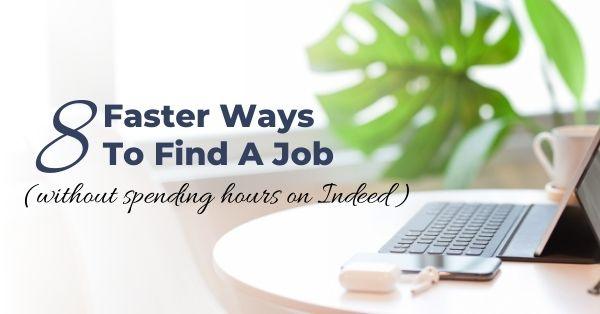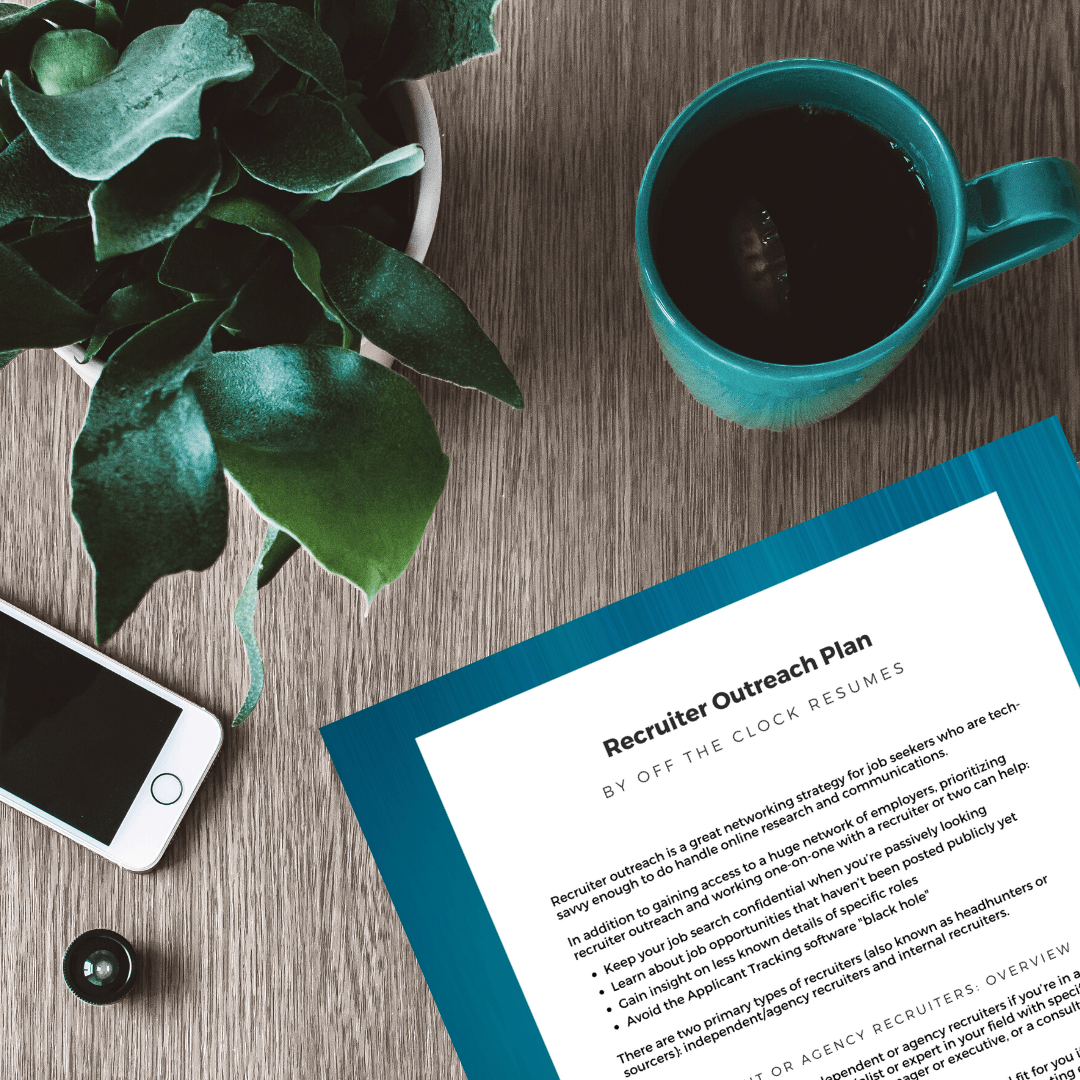
8 Faster Ways To Find A Job Without Spending Hours On Indeed (Or Other Job Search Sites)
A common complaint I hear from those knee-deep (or, in some cases, barely keeping their heads above water) in a job search is hearing nothing back from potential employers after spending countless hours scrolling through job boards, updating their resumes, and filling out never-ending online job applications.
You’re not the only one wondering if your resume or application is even reaching the right decision-makers.
While hiring trends are often universal, the recruiting process can vary across industries and individual companies. The majority of midsize to large corporations are using Applicant Tracking Systems or ATS to collect applications and narrow down candidates to be considered for interviews, but one HR team uses their ATS differently than the next HR team. Federal and state government agencies rarely use ATS at all!
What you don’t know happening behind the scenes at the companies you want to work for is the reason why you’re landing so few interviews and why your job search is taking so long!
You can still get your foot in the door, “Wow!” employers in an interview, and sign a job offer for your ideal next role but you’ll need to give up that Indeed job search. Stop spending so much time on Indeed or other job search sites and find your next job by using one of these 8 strategies for meeting decision-makers at the back door instead.

This blog contains affiliate links, meaning I may receive a small commission (at no cost to you) if you subscribe or buy something through the links I share. I only share links to products or services that I use myself or absolutely love!
Follow Up Frequently & Variously
Scratching your head already? I’m talking about utilizing various methods of communication to follow up consistently and stay top-of-mind after applying for a job online or attending an interview. When you sit back and wait for career moves to happen to you, you stay stuck and miss out on opportunities. One reason you may be stuck is you keep thinking following up looks like a handwritten letter (awkward) or formal email (also awkward and often not read).
You weren’t born yesterday, so use technology to your advantage instead! Following up looks like using LinkedIn to reach out to employees that work in the department you’re targeting or the HR team to let them know you recently applied and would love to hear more about their experience working for the company. Following up looks like sending a short email asking about your status application after one of your LinkedIn connections shares some insight on the hiring process.
Following up also looks like commenting on a LinkedIn post shared by the Company Page or one of the employee connections you made if they haven’t responded to your messages. Or actually calling the HR team if it’s been weeks with no response. While I’m not condoning “ghosting,” you just don’t know what’s happening behind the scenes whether budget cuts have shifted hiring priorities or your application disappeared in the ATS “black hole.”
(Most recruiters and HR professionals will be able to find you by searching for you but you have to follow up and introduce yourself first!)
Not sure how or when? This step-by-step Follow-up Plan includes a digital planner and templates to help you track and follow up consistently on job applications, networking efforts, and interviews
Work With A Staffing Agency
If you’re in a field with a shortage of talent, a specialist or expert in your field with specific or hard to find skills, an experienced manager or executive, a consultant, or a contractor looking for a temporary position, working with independent recruiters at a staffing agency is a great way to get in front of employers looking for someone like you.
Staffing agencies work with reputable companies that they know and trust, so you won’t be wasting your time on job scams. The recruiters at staffing agencies will work hard to get you hired since they’re often paid on commission. They also know about job opportunities that haven’t been posted publicly online yet, which will bump you to the front of the line for consideration.
Discover how to find and start working with staffing agencies in your job target location or that specialize in your field with this Recruiter Outreach Plan...
Share Your Career Goals With Others
Don’t just tell your mom you’re thinking about looking for a new job. Be crystal clear in describing what your ideal next role looks like to family, friends, family friends, colleagues in the field or industry you’re pursuing, former classmates that you’re still in touch with on a casual basis, and so on.
You’d be surprised by the business connections the people you know have. What may be even more surprising to you is that, according to LinkedIn Hiring Statistics, 48% of businesses say their top quality hires are employee referrals so you’re more likely to be interviewed when you have a connection on the inside than as a stranger submitting an online application.
This means getting laser-focused on how big your ideal employer looks like, what company culture or work environment you’ll thrive in, how much responsibility you want, which aspects of your past roles you loved the most, and which aspects you definitely don’t want to revisit if you can help it. Otherwise, the people you know won’t know how to best help you.
Start Talking To Others In Your Field & Industry
The word “networking” has such a negative stigma attached to it, right? Let’s simplify networking and knock it down a few pegs. Starting conversations is networking. You can do this on LinkedIn, Facebook, Instagram, messaging apps, or email. Granted, social media has made it easier to start conversations with the right people to get your foot in the door at companies you’d love to work for thanks to Company Pages, search features, and groups.
One of the most effective ways to expand your reach in your targeted field or industry is by joining Trade & Professional Association. Members get access to conventions, conferences, seminars, workshops, and other skill-building events as well as opportunities to find a mentor, mentor others, and job search support. Many of these opportunities are now available virtually, too.
Get my comprehensive list of associations for 30+ of the top career fields and 16 icebreakers that don’t start with “How are you?” or “What do you do?” with this step-by-step Trade & Professional Association Networking Plan…
Put Your LinkedIn Profile To Work For You
LinkedIn is used every day by the majority of recruiters and hiring professionals currently looking for candidates just like you. They can find you by using LinkedIn’s advanced search filters, sort and filter settings that narrow down applicants after you apply for a job on LinkedIn, and reviewing Recommended Matches before a job is even posted publicly on LinkedIn.
So, can they find you on LinkedIn?
A complete and keyword-optimized profile is the key to being found by recruiters and hiring managers on LinkedIn, especially if you’re being discreet in your job search or simply keeping your eyes open for new opportunities. Add the keywords they may use to find a candidate like you to your Headline, About section, job summaries under your Experience section, and your Skills section.
Find & Interact With Recruiters Directly On LinkedIn
While we’re on this topic, you don’t have to sit around and wait for recruiters and hiring managers to reach out to you on LinkedIn. LinkedIn is a networking platform, so it won’t be a turn-off to connect with HR team members at your top companies on LinkedIn.
Ask about what they love most about working for the company. Chat back-and-forth about challenges faced in the department you’d like to work for and how you’ve overcome similar challenges for past employers. Networking relationships like this have resulted in companies CREATING jobs for people they’d love to add to the team.
Want to take initiative and connect with internal recruiters on LinkedIn but are limited by a free LinkedIn account? I’ve got you covered with advanced search hacks in the Recruiter Outreach Plan...
Target Employers Instead Of Job Titles
Up until now, you’ve been job hunting all wrong. Hear me out: Job titles describe a wide range of skills and levels of experience that vary from industry to industry and often company to company. And job satisfaction is linked more to your experience at the company you work for than the responsibilities you hold.
So, why is your job search starting with a search that’s limiting your opportunities and potentially landing you in a job that you won’t absolutely love?
This starts with narrowing down what your ideal employer looks like based on your career goals. A large corporation or nonprofit organization in a city? A small family business in the suburbs? Research the companies that align with your industries of interest, your ideal work environment, and your values.
Seal the deal by networking with the employees who work at companies that match what your ideal employer looks like. LinkedIn makes this incredibly easy, but you can also attend local or regional job fairs these companies are represented at or local networking events their employees may attend.
Struggling to get your foot in the door? This step-by-step Employer Targeting Plan helps you narrow down what your ideal employer looks like and target those companies instead of job titles
Position Yourself On Social Media As A Must-Know
You’ve heard of “personal branding” by now, right? That’s another one of those buzzwords that seems to be difficult to define. The best definition I’ve found is:
“the conscious and intentional effort to create and influence public perception of an individual by positioning them as an authority in their industry, elevating their credibility, and differentiating themselves from the competition to ultimately advance their career, increase their circle of influence, and have a larger impact.”
Social media isn’t just for silent observation, the occasional “Like” or “Share” of memes, and business ads. You can boost your visibility and credibility as a must-know in your field by sharing tips and insights, stories that encourage and motivate, and recommendations.
To make this easier for even the most introverted social media avoiders, I’ve created a step-by-step plan for narrowing down what you want to be known and how to share your expertise online--and it will only take you a few minutes a week! You’ll find my favorite sites for personal branding, how to share photos and videos on social media strategically, what the deal is with hashtags, and your first month of social media posts in this Personal Branding Plan...
(College Graduate Edition, Career Change Edition, Mid-career Edition, and Executive Edition available!)
Conclusion
Job search sites like Indeed have statistically been the least effective strategy to find a job for years, but they’re still a go-to. You can find a job—particularly a job you love—much faster by utilizing recruiters at staffing agencies, professional associations, LinkedIn, and personal branding on social media to get your foot in the door and speed up your job search.




